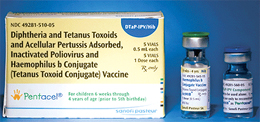Product
Pentacel
Approval Date
June 20, 2008
Release Date
August 15, 2008
Company
Sanofi Pasteur, Inc.
Class
DTaP-IPV+Hib/PRP-T
Indication
Active immunization against diphtheria, tetanus, pertussis, poliomyelitis and invasive disease caused by Haemophilus influenzae type b when administered to infants and children 6 weeks to 4 years of age (prior to fifth birthday).
Active Ingredient
Diphtheria Toxoid, Tetanus Toxoid, Pertussis Antigens (Detoxified Pertussis Toxin, Filamentous Haemagglutinin, Pertactin, Fimbriae Types 2 and 3), and polyribosyl-ribitol-phosphate capsular polysaccharide (PRP) of H. influenzae type b covalently bound to tetanus toxoid.
Agency Roster
Saatchi & Saatchi Healthcare Innovations
Marketing Strategy/Execution
Pentacel, a new pediatric combination vaccine from Sanofi Pasteur, the vaccines division of the Sanofi Aventis Group, was licensed by the FDA on June 23, 2008. Pentacel is the first and only 5-in-1 pediatric combination for immunization against diphtheria, tetanus, pertussis, polio, and Haemophilus influenzaetype b (Hib). Pentacel vaccine will be marketed to pediatricians and is approved for use in infants and children 6 weeks through 4 years of age (prior to fifth birthday). Pentacel vaccine is approved for administration as a four-dose series at 2, 4, 6 and 15-18 months of age. Pentacel vaccine has been used in Canada for a decade and is licensed in seven other countries. With a four-dose primary series of Pentacel vaccine, pediatricians can reduce the number of vaccination shots while providing protection against five diseases, including pertussis.
Also in the Pipeline (courtesy of Adis R&D Insight)
No competitor compounds in phase III or pre-registration, US.
Recent MM&M Coverage
The Top 60: Saatchi & Saatchi Healthcare Communications
Product news
Marketer takes helm of Sanofi vaccines division
Publicis picks up Sanofi vaccines PR
The Top 50: Saatchi and Saatchi Healthcare Communications
Pharmacology
Pentacel is a combination vaccine that can replace the separate injections of DTaP, IPV and Hib conjugate vaccines that are recommended for children through 2 years of age. It was developed to align well with the existing childhood vaccination schedule. Pentacel contains the same five acellular pertussis antigens as Daptacel (DTaP, also from Sanofi Pasteur), but Pentacel has a higher concentration of two of the antigens.
Clinical Trials
Pentacel was approved based on studies that established its immunogenicity for the five separate components compared to those of the separately-administered vaccines that are the current standard of care in the US: Daptacel (DTaP), IPOL (trivalent inactivated polio-virus vaccine), and ActHIB (Hib/PRP-T). A bridging study was also used to support the conclusion that Pentacel will provide protection against pertussis disease comparable to that established for Daptacel. Pentacel may be given concurrently with other vaccines (eg, MMR, varicella, hepatitis B, 7-valent pneumococcal conjugate vaccines).
Adverse Reactions
Local reactions: injection site erythema, swelling, tenderness. Systemic reactions: fever, crying, fussiness.
Adults
Not recommended.
Children
Each dose is 0.5mL IM, in anterolateral thigh (infants) or deltoid muscle. Give as a 4 dose series at 2 months, 4 months, 6 months, and 15–18 months of age. May give 1st dose as early as 6 weeks of age. Previously vaccinated with =1 dose of Daptacel, IPV, or Hib conjugate vaccine: Pentacel may be used to complete vaccination series; see literature. May give other vaccines concurrently (use separate inj site).
Contraindications
Anaphylaxis associated with previous dose or component. Encephalopathy within 7 days of a previous dose of a pertussis-containing vaccine. Progressive neurological disorder (eg, infantile spasms, uncontrolled epilepsy, progressive encephalopathy).
Precautions
Fever (=105°F within 48hrs), persistent inconsolable crying (lasting =3hrs within 48hrs), shock (within 48hrs), convulsions (within 3 days), or Guillain-Barre syndrome (within 6 weeks) of previous pertussis vaccine. Seizure risk (may pretreat with antipyretics, eg, acetaminophen). May defer in acute febrile illness. Have epinephrine (1:1000) available. Immune deficiency. Pregnancy (Cat.C): not recommended.
Interactions
Immunosuppressants: may get suboptimal response.








